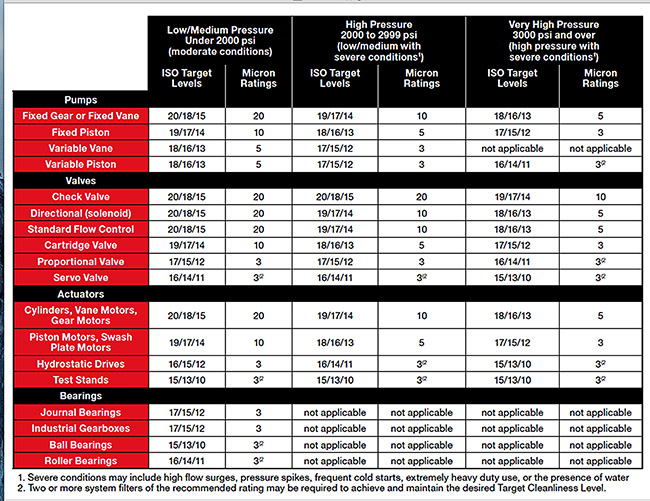Solid contamination in hydraulic fluids is subdivided into three groups: extremely hard, hard and soft particles. Dan Zoller, Group Product Manager Filter Systems, Schroeder Industries, explains that extremely hard particles can cause substantial damage in fluid power systems if they are not removed as quickly as possible. Preventive measures can reduce the ingress of contaminants in systems. However, even soft elements (e.g. fibers) can cause hydraulic components to get stuck and consequent damage to the system. In general, it is good practice to remove all types of particulates from the hydraulic fluid or system.

The Target Cleanliness Level is based on the most sensitive system components, system pressure and environmental conditions. The manufacturer of the hydraulic system can provide a recommended fluid ISO Target level. If this is not the case, refer to this table for guidance. Keep in mind that the Micron ratings of the filter(s) in the system have a great influence on what ISO Target Levels can be reached.
“An average healthy human eye can see items down to approximately 40 μm (microns) in size,” Zoller said. “In comparison, a human hair is 70 to 80 micron in diameter. Particles that cause problems in high performing, high pressure hydraulic systems are in the range of approximately 5 to 15 micron (μm). 1 μm is equal to 0.001 mm or 0.000039 in.”
ISO Code
“The objective of the ISO 4406:1999 (ISO Code) is to classify particulate contaminants in hydraulic fluids. Particle counts are determined cumulatively, i.e. > 4 μm, > 6 μm and > 14 μm, and coded for easy comparison (e.g. ISO Code 17/15/12),” Zoller said.
“In hydraulic systems, 70 to 90% of wear and failure is contamination related. Only 10 to 30% can be traced back to misuse, defects or age. Contamination cannot be stopped, only slowed down!”
Results of contamination
Zoller noted that particulate contaminants circulating in fluid power systems cause surface degradation through general mechanical wear (abrasion, erosion, and surface fatigue). “This wear causes increasing numbers of particles to be formed, the result being that wear increases if the ‘chain reaction of wear’ is not properly contained (by reducing contamination). Gaps grow larger, leakage oil flows increase in size and operating efficiency (e.g. of pumps, cylinders) decreases.”
Critical issues
Hydraulic component clearances are critical and require strategic filtration to remove damaging particles. Critical clearances for individual hydraulic components are in the Micron range and depend on the individual component: E.g. Servovalves have clearances of 1 to 4 microns, while “Control Valves might be in the range of up to 25 micron. In addition, the system pressure level has influence on the recommended cleanliness level. Higher pressure requires lower contamination levels (lower ISO codes).”
“Target Cleanliness Level is based on the most sensitive system components, system pressure and environmental conditions. Normally, the manufacturer of the hydraulic system can provide a recommended fluid ISO Target level to use. If not, a table as noted below can be used as a guide,” Zoller said.
By Joyce Laird
The post How do you set a target fluid cleanliness level? appeared first on Sealing & Contamination Control Tips.
Filed Under: Filtration/Contamination Control, Sealing & Contamination Control Tips